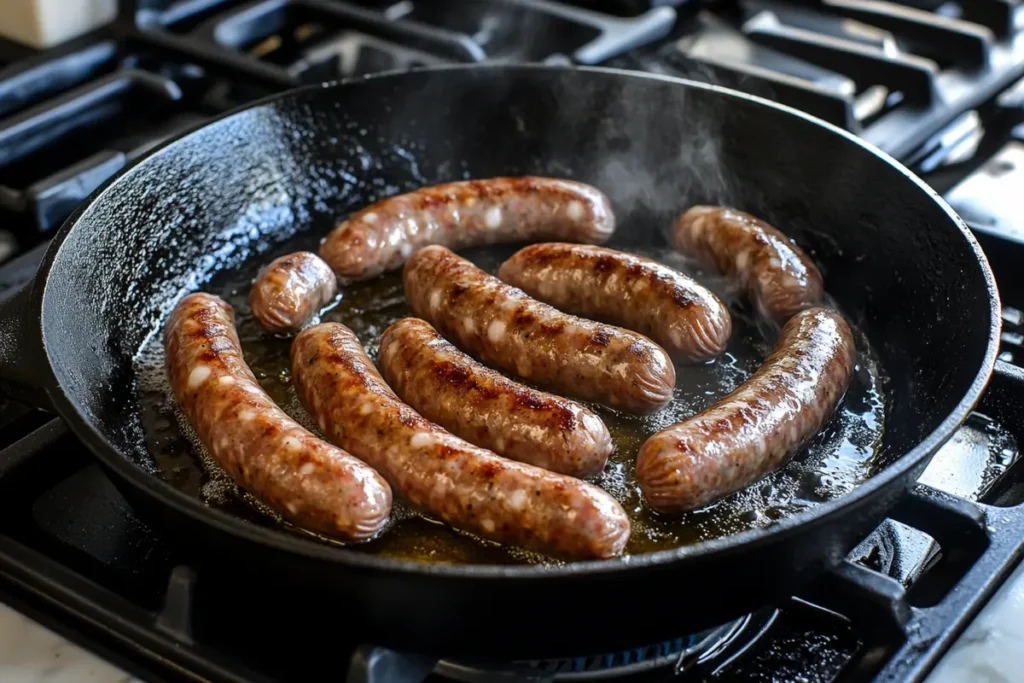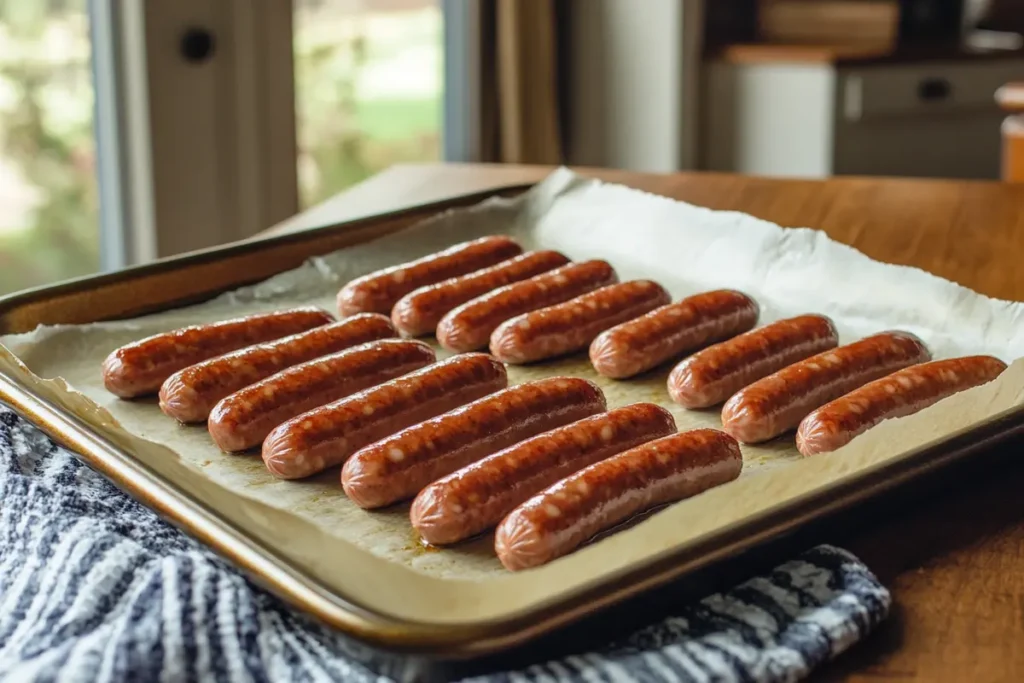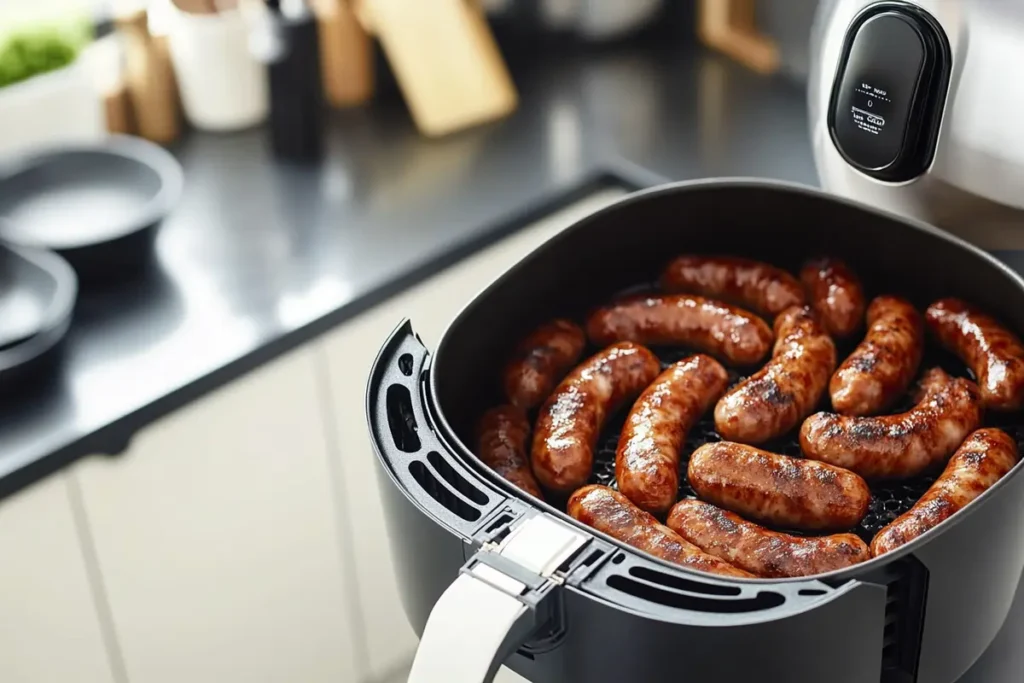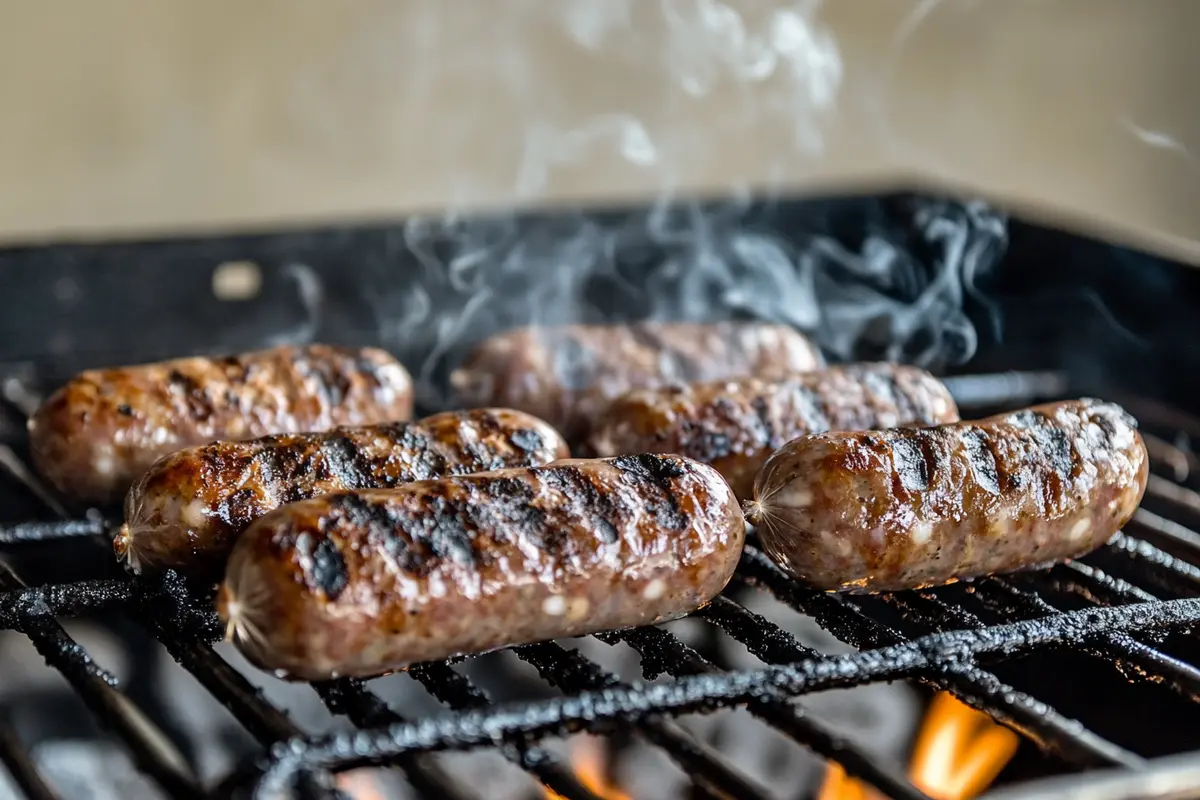Cooking beef sausages to perfection can seem like an art, but with the right approach, it’s surprisingly simple! Whether you’re craving that smoky grilled flavor, a crispy pan-fried texture, or the convenience of baking or air frying, each method has its perks. This guide delves deep into every cooking technique, helping you bring out the rich flavors and juicy textures of beef sausages. Plus, we’ll explore preparation tips, serving ideas, and even answer some FAQs to ensure you have all bases covered.
Introduction to the Best Way to Cook Beef Sausages
What Is the Best Way to Cook Beef Sausages?
If you’ve ever wondered what’s the best way to cook beef sausages, you’re not alone! There isn’t a one-size-fits-all answer, as each method has its advantages depending on your taste preferences, time, and tools. From the traditional grilling approach to modern air frying, understanding how to cook sausages ensures every bite is bursting with flavor.
The trick to cooking sausages well lies in balancing heat and time. Overcooking can make them dry and tough, while undercooking can leave them unsafe to eat. So, achieving that sweet spot where the sausages are cooked through, juicy, and flavorful is key. Let’s dive into the world of beef sausages and uncover the secrets to their perfect preparation.
Understanding Beef Sausages
What Are Beef Sausages?
Beef sausages are a staple in kitchens worldwide, crafted from ground beef mixed with a blend of herbs, spices, and sometimes fillers, all encased in either natural or synthetic casings. The casings give them their signature shape and help retain their juicy goodness during cooking. While some varieties feature simple seasoning, others may include bold flavors influenced by specific cuisines, like smoky paprika, garlic, or even zesty herbs.
You’ll find beef sausages in fresh, cured, or smoked forms, making them incredibly versatile. From hearty breakfast plates to sizzling barbecue feasts, these sausages shine in almost any dish. Whether you prefer traditional recipes or innovative twists, beef sausages are a crowd-pleasing ingredient that’s easy to prepare and packed with potential.
Nutritional Profile of Beef Sausages
Packed with protein, beef sausages are a convenient way to fuel your body with essential nutrients like iron, zinc, and B vitamins. These components support energy levels, muscle repair, and immune health. However, they also come with a caveat—many beef sausages are high in saturated fats and sodium, especially when processed.
Moderation is the name of the game. Opt for varieties with a high percentage of lean meat and fewer added preservatives. This way, you can enjoy their savory flavor while making a mindful choice. Pair them with healthy sides, such as steamed vegetables or whole-grain options, to balance your meal without compromising taste.
Preparation Before Cooking
Selecting Quality Beef Sausages
When it comes to cooking beef sausages, starting with quality ingredients makes all the difference. Look for sausages with a meat content of at least 80%—the higher, the better! High-quality options often use fewer fillers like breadcrumbs or soy, ensuring a richer flavor and better texture.
Shopping locally at a butcher’s shop can provide access to fresher and more customizable choices. But if you’re buying pre-packaged sausages, check the ingredient list and avoid artificial additives. The color should be vibrant but not overly bright, which might indicate dyes. Finally, remember to match the sausage type to your intended cooking method—for example, opt for thicker casings for grilling, as they hold up better under high heat.
Thawing and Handling Sausages Safely
Proper thawing and handling are essential for maintaining the quality and safety of your beef sausages. For frozen sausages, thaw them gradually in the refrigerator overnight. Avoid defrosting at room temperature, as this can encourage bacterial growth.
When handling raw sausages, always work with clean hands and utensils. Keep raw and cooked items separate to avoid cross-contamination. If you’re in a rush, you can use a microwave’s defrost setting, but be cautious not to start cooking them unevenly. By adhering to safe practices, you’re setting the stage for deliciously cooked beef sausages without compromising your health.
Cooking Methods
Grilling Beef Sausages
Grilling is one of the most popular ways to cook beef sausages, offering that irresistible smoky flavor that screams summer barbecue. To start, preheat your grill to medium heat. A temperature too high can burn the outside while leaving the inside undercooked, so moderation is key. Lightly oil the grill grates to prevent sticking.
Place the sausages on the grill and cook them for 15–20 minutes, turning occasionally for even browning. The goal is to achieve a deliciously golden, slightly charred exterior while ensuring the internal temperature reaches 160°F (71°C). Using a meat thermometer makes this process foolproof.
For added flavor, you can use indirect grilling for thicker sausages. This method involves cooking them away from direct heat, allowing them to cook slowly and evenly. Grilling not only enhances their taste but also lets excess fat drip away, making them a slightly healthier option.
Pan-Frying Beef Sausages
When you need a quick and savory option, pan-frying is the way to go. This method creates a crispy, golden crust while locking in the juices. Start by heating a tablespoon of oil in a non-stick or cast-iron skillet over medium heat.
Once the pan is hot, add the sausages, ensuring they don’t overcrowd the skillet. Cook them for 12–15 minutes, turning frequently for even browning. Keep an eye on them to prevent sticking or burning. The sausages are done when their internal temperature reaches 160°F (71°C), and they have a uniform golden color.
For even cooking, you can pierce the casings lightly before frying, allowing some steam to escape. However, this might lead to slight moisture loss, so it’s a trade-off. Pair these pan-fried delights with sautéed veggies or mashed potatoes for a hearty meal.

Baking Beef Sausages
For a hassle-free and consistent cooking method, baking is your best bet. Begin by preheating your oven to 400°F (200°C). Line a baking sheet with parchment paper or foil for easy cleanup.
Arrange the sausages in a single layer, leaving enough space between them to allow for even airflow. Bake them for 20–25 minutes, flipping them halfway through for even browning. Use a meat thermometer to confirm they’ve reached the ideal internal temperature of 160°F (71°C).
Baking is perfect for preparing large batches of beef sausages at once, making it a time-saver for busy households. Additionally, it’s a healthier option since you don’t need extra oil. Serve these baked beauties with a side salad or roasted vegetables for a balanced meal.

Boiling and Simmering Beef Sausages
Boiling and simmering are gentle, foolproof methods for cooking beef sausages. They’re especially useful for plumping sausages or preparing them before grilling or frying.
Fill a pot with enough water to fully submerge the sausages, then bring it to a gentle simmer—avoid boiling vigorously, as this can cause the casings to split. Add the sausages and cook them for 15–20 minutes.
Once done, you can serve the sausages as-is or finish them off with a quick sear in a pan for extra flavor. Simmering ensures even cooking and helps retain moisture, making the sausages tender and juicy. For an added touch, try simmering them in broth or with aromatic herbs to infuse subtle flavors.
Using an Air Fryer for Beef Sausages
For a modern and healthier twist, try cooking beef sausages in an air fryer. Start by preheating the air fryer to 375°F (190°C).
Place the sausages in the air fryer basket in a single layer to ensure even airflow. Cook them for 10–12 minutes, flipping them halfway through to achieve an even, crispy finish. This method is quick and uses minimal oil, making it a great choice for health-conscious cooks.
The circulating hot air in the fryer creates a crispy outer layer while locking in the juicy interior. Plus, cleanup is a breeze compared to traditional frying. Pair these air-fried sausages with a light salad or whole-grain bread for a satisfying meal.
Air frying combines convenience and taste, proving that cooking sausages can be as modern as it is flavorful!

Tips for Perfectly Cooked Beef Sausages
Ensuring Even Cooking
The secret to perfectly cooked beef sausages lies in even heat distribution. Overcrowding your cooking surface—whether it’s a grill, skillet, or oven—prevents proper airflow and leads to uneven cooking. When sausages are packed too tightly, the heat struggles to penetrate, leaving some spots undercooked and others overcooked.
Space each sausage apart, giving them room to cook evenly on all sides. If you’re grilling, flip the sausages regularly to ensure each side gets its fair share of heat. For oven baking, consider using a rack to lift the sausages, allowing heat to circulate beneath. Similarly, when pan-frying, avoid overcrowding your skillet, opting for smaller batches if necessary.
This simple tip ensures every sausage is cooked to juicy perfection, delivering that balance of flavor and texture we all crave.
Checking for Doneness
Nothing ruins a meal faster than biting into an undercooked sausage—or worse, one that’s dry and overdone! To avoid such disappointments, use a meat thermometer to verify doneness. Insert the thermometer into the thickest part of the sausage without touching the casing.
The USDA recommends cooking beef sausages to an internal temperature of 160°F (71°C). This ensures harmful bacteria are eradicated while preserving the sausage’s juicy interior. If you don’t have a thermometer, you can perform a visual check: cut into the center of a sausage. The meat should no longer be pink, and the juices should run clear.
Remember, a thermometer takes the guesswork out of cooking, making it an indispensable tool for achieving perfectly cooked sausages every time.
Resting Time After Cooking
After pulling your sausages off the heat, resist the urge to dive right in! Resting sausages for 3–5 minutes allows the juices to redistribute throughout the meat. Cutting into them immediately can cause those flavorful juices to escape, leaving your sausages dry.
During resting, the temperature inside the sausage continues to rise slightly, ensuring a fully cooked interior without overcooking. Whether you’re grilling, baking, or frying, this short resting period ensures the sausages are moist, tender, and packed with flavor.
Serving Suggestions
Pairing with Sides
One of the joys of beef sausages is their versatility, and pairing them with the right sides can elevate your meal. For a classic combination, serve them with creamy mashed potatoes and a dollop of tangy mustard. Alternatively, grilled vegetables like bell peppers, zucchini, and onions add a fresh, smoky contrast to the savory sausages.
For lighter fare, pair sausages with a crisp green salad, dressed with a zesty vinaigrette. Traditional accompaniments like sauerkraut or coleslaw also complement the bold flavors of the sausages. Want something heartier? Try serving them alongside baked beans or crusty bread for a satisfying, rustic meal.
By mixing and matching your sides, you can tailor your meal to suit any occasion, from casual weeknight dinners to weekend gatherings.
Incorporating into Recipes
Sliced or diced, beef sausages can transform a dish from ordinary to extraordinary. Add them to pasta dishes for a protein-packed twist—try combining sausage slices with penne, marinara sauce, and a sprinkle of Parmesan for a simple yet hearty dinner.
In stews or soups, sausages add depth and richness, pairing beautifully with root vegetables and legumes. They’re also fantastic in casseroles—layer them with potatoes, cheese, and a creamy sauce for a crowd-pleasing bake. Feeling adventurous? Use cooked sausages as a pizza topping, or toss them into scrambled eggs for a flavorful breakfast.
Whether they’re the star ingredient or a flavorful addition, beef sausages bring hearty, savory goodness to any recipe.
Frequently Asked Questions
How Long Should I Cook Beef Sausages?
The cooking time for beef sausages depends on the method you choose. For pan-frying or grilling, it typically takes 12–15 minutes over medium heat, with occasional turning to ensure even cooking. Baking in the oven takes about 20–25 minutes at 400°F (200°C). Boiling or simmering requires roughly 15–20 minutes, while air frying takes a quick 10–12 minutes at 375°F (190°C).
No matter the method, it’s crucial to use a meat thermometer to check the internal temperature. Sausages are safe to eat when they reach 160°F (71°C) in the center. Avoid relying solely on cooking times, as factors like sausage thickness and heat intensity can vary. Monitoring the temperature ensures perfect results every time.
Can I Cook Beef Sausages from Frozen?
Yes, you can cook beef sausages straight from the freezer, but it will take longer than cooking thawed sausages. When grilling or pan-frying, start with low heat to defrost the sausages gently. Once thawed, increase the heat to cook them evenly.
For oven baking, add 5–10 extra minutes to the usual cooking time. If boiling or simmering, frozen sausages will take approximately 25–30 minutes. While cooking from frozen is convenient, it’s not ideal for even results. Thawing in the refrigerator overnight allows the sausages to cook more consistently, preventing a dry exterior with an undercooked interior.
What Is the Healthiest Way to Cook Beef Sausages?
If you’re looking for a healthier approach, boiling and baking are excellent methods. Boiling requires no added fat and retains the sausage’s natural moisture, making it both lean and tender. Baking is another healthy option, as it eliminates the need for oil and allows excess fat to drip off during cooking.
Grilling also reduces fat content by letting grease drip away from the sausages. However, avoid high heat, which can cause charring. Pair these cooking methods with nutrient-rich sides like steamed vegetables or a fresh salad to create a balanced, healthy meal.

